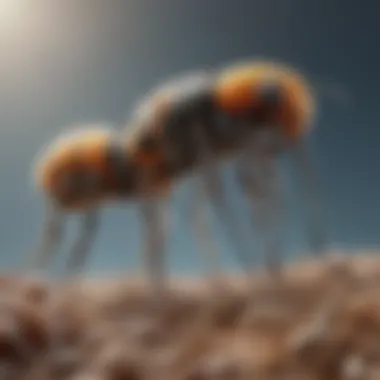Understanding Tandem Insecticide: Applications and Implications


Intro
Tandem insecticides are becoming a significant topic in modern pest management systems. As households and gardens become increasingly susceptible to various pests, understanding these insecticides is essential. This guide aims to provide homeowners and gardening enthusiasts with detailed insights into tandem insecticides, their applications, and implications. Knowing how these products function is a step towards effective pest control while being mindful of environmental impact.
Understanding the Pest
Effective pest management starts with understanding the pests you are dealing with. Identifying the pest is crucial in determining the best control strategy.
Identification
Different pests can cause varying degrees of damage to your plants or home. Identifying these pests involves recognizing their physical features, behaviors, and the damage they inflict. Common household pests include aphids, termites, and cockroaches. Each has unique signs that point to their presence. For instance, aphids are small and often found on the underside of leaves, while termites may produce wood shavings or mud tubes near their nests.
Life Cycle
Understanding the life cycles of these pests is equally important. Most pests have specific stages of development. For example, the lifecycle of a cockroach includes an egg, nymph, and adult stages. By targeting specific stages with appropriate insecticides, you can enhance your pest management efforts. Knowing the peak seasons for pest activity can also help you prepare and implement timely control measures.
Pest Prevention Strategies
To effectively manage pests, it's best to take preventive measures. This reduces reliance on chemical controls like tandem insecticides.
Environment Modification
Making changes in the environment can discourage pest infestations. Maintaining cleanliness in your home, sealing cracks, and removing standing water can significantly reduce the likelihood of pests entering your space. For gardens, rotating crops and selecting pest-resistant plant varieties are effective approaches.
Physical Barriers
Physical barriers, such as netting or screens, can also help protect plants from pests. Installing fine mesh around gardens can keep larger pests away while allowing sunlight and rain to reach the plants.
Control Methods
Once pests have been identified, and preventive measures taken, it's time to consider control methods. Chemical and biological strategies are two primary options.
Chemical Control
Tandem insecticides are mixtures of chemical compounds that target pests effectively. They often work by interfering with the insect's nervous system or disrupting its life cycle. Proper application is key to minimizing risks to non-target organisms, including beneficial insects and humans.
Biological Control
Implementing biological control methods can complement chemical strategies. This involves using natural predators or parasites to manage pest populations. For instance, ladybugs can control aphid populations in gardens. Biological control is often more sustainable and has less environmental impact compared to chemical methods.
"A balanced approach combining prevention, chemical, and biological strategies can lead to more effective pest management."
Prolusion to Tandem Insecticides
Tandem insecticides play a significant role in modern pest management strategies. Understanding their application is crucial for homeowners, gardeners, and pest management professionals. This section will discuss the definition, purpose, and historical context of tandem insecticides. By analyzing these elements, readers can appreciate their importance in effective pest control while considering responsible usage practices.
Definition and Purpose
Tandem insecticides refer to products that combine multiple active ingredients to target pests more effectively. Often, these ingredients complement each other, enhancing efficacy. The primary purpose of tandem insecticides is to control a wide range of pests while minimizing the risk of resistance. They can be used in various settings, from agriculture to residential areas.
By employing tandem insecticides, users can achieve a more robust pest control solution. This is particularly important as pests evolve, displaying resistance to single active ingredients. A blended approach can reduce the likelihood of resistance development while also broadening the spectrum of pests managed.
History and Development
The development of tandem insecticides is intertwined with advancements in pest control practices. Historically, pest control relied heavily on single active ingredients. However, as the scientific understanding of pest biology and ecology grew, so did the approach to pest management. The introduction of tandem formulations emerged in response to the limitations faced by traditional insecticides.
Over time, researchers identified the potential benefits of combining different active substances. This led to formulations that not only improved effectiveness but also reduced environmental impact. The continuous evolution of tandem insecticides reflects the industry's commitment to finding more sustainable and effective pest management solutions.
While challenges remain, understanding the history and development of tandem insecticides can foster a deeper appreciation for their role in modern pest control strategies.
Composition of Tandem Insecticides
The composition of tandem insecticides forms the foundation of their effectiveness in pest management. Understanding what these products contain is vital for assessing their utility and safety in various contexts. A thorough exploration of their components reveals not only their mechanisms of action but also how they interact within the ecosystem. This section outlines the active ingredients and the synergistic effects that enhance their performance, providing insights into their design and use.
Active Ingredients
Active ingredients are the substances in a tandem insecticide that target pests. These chemicals are responsible for the insecticidal action, directly impacting the pest population upon application. Common active ingredients include lambda-cyhalothrin, bifenthrin, and imidacloprid. Each ingredient serves a specific function, often targeting different pest species or stages of their life cycle. For instance, lambda-cyhalothrin is a pyrethroid that disrupts the nervous system of insects. This allows for quick knockdown of larger pest populations, making it a valuable component.
When choosing a tandem insecticide, it is crucial to consider the active ingredients in relation to the targeted pest. This ensures greater efficacy and reduces the likelihood of resistance development. In addition, recognizing the residual activity of these ingredients aids in determining the timing of follow-up applications.


Synergistic Effects
The concept of synergistic effects is central to the design of tandem insecticides. This principle involves combining active ingredients that, when used together, produce a substantially improved outcome compared to their individual use. Through careful formulation, synergistic relationships enhance potency, leading to more effective pest control.
An example of this is the pairing of a pyrethroid and a neonicotinoid. Pyrethroids provide rapid knockdown while neonicotinoids disrupt the insect's feeding behavior over a longer period. As a result, pests are not only eliminated quickly but also experience an extended period of exposure, reducing their population more effectively.
Effective pest management relies not only on the individual components of insecticides but also on their interactions.
However, it is important to understand that these synergistic effects can also raise concerns regarding environmental impact. Not all combinations are safe for non-target organisms. Homeowners and pest management professionals must consider these implications when selecting products for specific applications, ensuring that benefits outweigh potential risks.
In summary, the composition of tandem insecticides is critical for their performance. Knowledge of active ingredients and their synergistic effects enhances pest management effectiveness while promoting responsible usage. This understanding empowers users to make informed choices, enhancing their ability to manage pest populations sustainably.
Mechanisms of Action
Understanding the mechanisms of action of tandem insecticides is critical for effective pest management. This section outlines how these chemicals operate to control pest populations, focusing on specific pest targets, the biochemical interactions involved, and strategies for managing resistance. By comprehending these aspects, users can apply tandem insecticides more effectively while minimizing any potential negative impact.
Targeted Pest Types
Tandem insecticides are designed to address a wide variety of pests. Common targets include aphids, whiteflies, and various caterpillars. Each of these pests poses unique challenges to crops and gardens.
- Aphids: These small insects reproduce quickly and can decimate plant health. Tandem insecticides disrupt their feeding and development, ensuring that their population is kept in check.
- Whiteflies: Known for their resilience, whiteflies can infest numerous plants. By targeting their life cycle, tandem insecticides can limit their spread.
- Caterpillars: Often more destructive, caterpillars can destroy entire crops. The effectiveness of tandem formulations against them emphasizes their importance in agricultural settings.
Biochemical Interactions
The efficacy of tandem insecticides relies on their biochemical interactions with pest physiology. These chemical compounds often work through multiple modes of action. They might inhibit neural functions or disrupt hormonal balances.
- Neurotransmission Disruption: Tandem insecticides can interfere with the nervous systems of pests. This disruption causes immediate paralysis and death, ensuring rapid control.
- Hormonal Disruption: Some active ingredients may alter growth hormones in insects. This alteration can prevent development, leading to population decline over time.
Such biochemical interactions are valuable not only for immediate pest control but also for long-term management of pest populations.
Resistance Management
Resistance management is a critical component when using tandem insecticides. Pests can develop resistance over time, leading to reduced effectiveness of treatments. To combat this challenge, following best practices is essential.
- Rotation of Active Ingredients: Users should rotate different products to avoid continuous exposure of pests to the same active ingredients. This practice helps to slow down the development of resistance.
- Integrating Non-Chemical Methods: Using cultural control methods alongside chemicals can enhance overall effectiveness. Non-chemical strategies, such as crop rotation and biological control, can reduce reliance on tandem insecticides alone.
"Preventing resistance is as important as immediate pest control measures. Integrative approaches will lead to sustainable pest management."
In summary, understanding the mechanisms of action for tandem insecticides encompasses knowing the specific pests targeted, the biochemical processes involved, and strategies for managing potential resistance. Such knowledge leads to more informed and responsible usage in pest management practices.
Applications in Pest Management
The role of tandem insecticides in pest management is crucial for maintaining healthy ecosystems and productive agricultural systems. These formulations are designed to deliver effective results against a wide range of pests while minimizing potential risks. Understanding their applications helps to maximize their benefits and address any issues that may arise during their use. This section will detail their significance across various domains including agriculture, residential settings, and integrated pest management strategies.
Agricultural Usage
In agriculture, tandem insecticides are instrumental in protecting crops from significant pest infestations. Farmers rely on these products to manage known pest species effectively, ensuring crop yield and quality. The use of tandem insecticides can contribute to sustainable agriculture by reducing reliance on single-mode insecticides that may lead to resistance over time. The interactive ingredients within these products can target multiple pest pathways, enhancing efficacy and potentially reducing the frequency of applications.
Several considerations are critical when using tandem insecticides in agricultural practices. Weather conditions, crop type, and pest life cycles play significant roles in determining the timing and method of application. Farmers must also observe the packaging instructions carefully to optimize effectiveness and minimize any potential negative effects on non-target species.
"Utilizing tandem insecticides can lead to higher yield and better crop quality, provided they are applied thoughtfully."
This complexity is balanced by growers' increasing gravitation towards eco-friendly practices, aligning with trends in sustainable agriculture. The correct implementation of these insecticides encourages crop resilience against pest threats while promoting environmental health.
Residential and Commercial Use
In residential and commercial settings, tandem insecticides serve a dual purpose. They not only manage pest populations but also enhance the comfort and safety of living and working environments. Homeowners often face infestations from insects such as ants, spiders, and cockroaches. Utilizing tandem insecticides allows for targeted control of such pests, reducing their presence effectively.
Finding the right tandem insecticide for residential use involves knowledge of the specific pests to be controlled. Some formulations are safe for use indoors, effectively addressing household pests without posing a risk to children or pets. However, it is essential to follow usage guidelines on the product labels carefully, as improper application can lead to unwanted exposure or environmental contamination.
For commercial properties, maintaining pest-free conditions is even more critical. Businesses that deal with food production or customer service sectors must adhere to strict health regulations. Tandem insecticides can assist in compliance by ensuring pests are managed before they become a significant problem.
Integrated Pest Management (IPM)
The concept of Integrated Pest Management (IPM) emphasizes sustainable methods of controlling pest populations without negatively impacting the environment. Tandem insecticides fit well within the IPM framework, offering a multifaceted approach to pest management. In this context, they are used in conjunction with other pest-control methods such as biological control, habitat manipulation, and cultural practices.
Within IPM, the objective is to utilize tandem insecticides judiciously, focusing on monitoring pest populations and applying treatments only when necessary. This method not only reduces pesticide reliance but also supports the maintenance of biodiversity and ecological health. By integrating biological pest control, such as encouraging natural predators, with the chemical methods of tandem insecticides, pest management becomes more balanced.
Emphasizing the responsible use of tandem insecticides within IPM can lead to long-term success in pest control, fostering a healthier interaction between agricultural practices and the environment. This holistic approach can ultimately mitigate issues related to pest resistance and ecological disruption.
Effectiveness and Limitations


The effectiveness and limitations of tandem insecticides are crucial aspects that merit careful consideration. This section sheds light on how these insecticides function against target pests, as well as the constraints they encounter in ecological settings. Understanding these elements is vital for housewives, homeowners, and gardening enthusiasts aiming to maintain healthy environments while managing pests effectively.
Efficacy Against Target Pests
Tandem insecticides, known for their dual-action formulation, often demonstrate significant efficacy against various pest species. Their unique combination of active ingredients enables a more profound impact on targeted insects. This effectiveness is observed in pests such as aphids, whiteflies, and spider mites, leading to quick knockdown and longer-lasting control.
The role of toxicity is paramount here. These insecticides not only disrupt the nervous system of the pests but also impair their reproductive capabilities. By targeting both adults and larvae, tandem insecticides ensure fewer opportunities for these pests to reproduce and thrive. Moreover, their systemic nature allows for movement within the plant, where they can effectively reach pests hidden within foliage.
Challenges remain, however. Some pests may develop resistance, reducing the effectiveness of tandem insecticides over time. Thus, it is essential to integrate different pest management strategies to mitigate this risk. Active monitoring of pest populations can help in applying tandem insecticides more judicially, ensuring that these products maintain their effectiveness.
Limitations in Ecological Contexts
Despite their efficacy, tandem insecticides have notable limitations, particularly concerning their environmental impact. Application in residential and commercial spaces poses risks to non-target species and the overall ecosystem health. For instance, bees and other beneficial insects may be affected unintentionally. When applied incorrectly, there can be substantial collateral damage which disrupts local biodiversity.
Moreover, the persistence of certain active ingredients poses a dilemma. While long-lasting effects against target pests are advantageous, they can lead to soil and water contamination. Runoff from treated areas can carry these chemicals into waterways, which in turn impacts fish and amphibians.
It is vital to remain cognizant of such ecological implications when considering the use of tandem insecticides. The need for responsible application methods is paramount. Homeowners should follow recommended practices closely and explore alternatives when necessary.
"Understanding the balance between effective pest control and environmental health is essential for sustainable gardening."
In summary, while tandem insecticides can provide essential benefits in pest control, their effectiveness and limitations underscore the importance of responsible usage. Addressing these aspects allows users to make informed choices that align pest management with ecological stewardship.
Environmental Considerations
Understanding the environmental considerations of tandem insecticides is crucial for ensuring their responsible use. These products, while effective in pest management, can also pose risks to ecosystems if not applied carefully. Balancing effective insect control with environmental protection requires awareness of various effects these insecticides can have on non-target species and natural resources like soil and water.
Impact on Non-Target Species
The use of tandem insecticides can result in unintended consequences for non-target species. These include beneficial insects such as bees, ladybugs, and other pollinators that play essential roles in plant reproduction and pest control. Studies indicate that certain active ingredients used in tandem insecticides can affect the behavior and population dynamics of these non-target organisms.
It is important for homeowners and pest management professionals to consider the timing and method of application to minimize non-target exposure. For instance, spraying during cooler hours when pollinators are less active can significantly reduce their risk. Furthermore, selecting products specifically designed to target pest species can also help to mitigate non-target effects.
"Integrating eco-friendly practices in pest control can protect biodiversity while still managing pests effectively."
Soil and Water Safety
Soil and water safety must be at the forefront of any discussion about the environmental impacts of tandem insecticides. When these chemicals are applied, there is a potential for runoff, especially during periods of rain. This runoff can lead to water contamination, which affects aquatic life and can degrade the quality of local water supplies.
Proper management includes:
- Buffer Zones: Creating buffer zones of vegetation around water bodies can trap potential runoff, allowing it to filter through natural processes.
- Application Timing: Avoiding application before heavy rains helps prevent runoff.
- Soil Health Practices: Utilizing practices that enhance soil health can reduce the leaching of chemicals through the ground.
Regular assessments of local water bodies for pesticide residue assist in understanding the impact of tandem insecticides on water quality. Homeowners should also consider using organic alternatives when possible, as these typically have lesser ecological footprints.
Regulatory Framework
Understanding the regulatory framework surrounding tandem insecticides is crucial for both users and manufacturers. This framework encompasses the guidelines and systems in place to ensure that these products are safe and effective for the intended pest control applications. Regulatory bodies enforce regulations that protect public health, the environment, and agricultural integrity. Complying with these regulations fosters consumer confidence in the products available in the market.
Approval Processes
The approval process for tandem insecticides involves a rigorous evaluation by regulatory agencies such as the Environmental Protection Agency (EPA) in the United States. This process assesses a product's safety, efficacy, and potential environmental impacts before granting permission for sale and use.
Key elements of the approval process include:
- Toxicological Testing: Manufacturers must provide data on the potential health risks associated with the chemicals in tandem insecticides. This includes studies on how these ingredients affect humans, wildlife, and beneficial insects.
- Environmental Impact Assessments: An analysis of how the product may affect soil health, water sources, and non-target species is vital. The aim is to ensure that the benefits of pest control do not compromise ecosystem integrity.
- Efficacy Trials: The product must demonstrate its effectiveness against specific pests under various conditions. This offers real-world assurance to users about its performance.
The processes ensure that any new tandem insecticide introduced to the market has undergone thorough scrutiny. This not only safeguards users but uplifts the standards within the pest management industry.
Labeling Requirements
Labeling is paramount for the safe use of tandem insecticides. Regulatory authorities mandate that product labels contain clear, concise, and transparent information, ensuring that users understand application methods, safety precautions, and potential risks. Crucial components of labeling requirements include:
- Active Ingredients Disclosure: The label must identify all active ingredients within the product, allowing users to make informed choices based on their needs and pest pressures.
- Usage Instructions: Detailed instructions for proper product application, including recommended dosages, frequency, and timing, greatly enhance the safety and efficacy of the insecticide.
- Safety Precautions: Labels must highlight any necessary safety measures, including protective gear suggestions, first-aid instructions, and environmental warnings to minimize potential harm.
- Disposal Guidelines: Proper disposal methods to avoid environmental contamination must also be stated. This is crucial in promoting responsible use and stewardship of chemical products.
Clarity in labeling not only enables better pest control strategies but also reinforces public trust in pest management practices.
By adhering to established regulations, manufacturers contribute to a sustainable approach to pest management, balancing agro-ecological health and pest control efficiency.
Best Practices for Application
Applying tandem insecticides effectively requires careful consideration of various factors. Following best practices ensures not only the success of pest management efforts but also the minimization of risks to non-target organisms and the environment. These practices ultimately enhance the reliability and safety of pest control strategies.


Timing and Dosage Guidelines
Timing is critical when using tandem insecticides. The right application time can greatly influence the effectiveness of the treatment. Generally, applications should be made during peak pest activity. For many pests, this corresponds with specific growth stages where they are most vulnerable to insecticides.
Dosage also plays a key role in efficacy. Using the correct dosage as recommended on the product label is vital. Under-dosing may not effectively control the target pest, while overdosing can lead to increased risk of resistance development. It's essential to follow guidance on dosage carefully to ensure a balance between effectiveness and environmental safety.
Key factors to consider when determining timing and dosage include:
- Temperature and humidity, which can affect insect behavior and chemical efficacy.
- Forecasted weather conditions, as rain can wash away sprays and render them ineffective.
- Pest life cycle, ensuring that treatments coincide with vulnerable stages.
"Adhering to timing and dosage guidelines is crucial for the optimal performance of tandem insecticides."
Spray Techniques and Equipment
The method of application significantly influences the outcome of pest control measures. Using the proper spray technique ensures that the insecticide reaches its target effectively while minimizing drift. Here are several important considerations when selecting spray techniques and equipment:
- Nozzle type: The choice of nozzle affects the droplet size and distribution. Different nozzles can create finer sprays for larger areas or coarser sprays for localized treatment.
- Spray pressure: Adjusting the spray pressure properly can affect droplet size and the uniformity of pesticide distribution.
- Calibration: Regularly calibrating equipment before use ensures that the correct amount of insecticide is applied. Calibration helps in achieving accuracy, efficiency, and consistent results.
In addition to techniques, consider the following equipment features:
- Personal protective equipment (PPE): Always ensure that the applicator wears suitable PPE to avoid exposure.
- Booms and tanks: Select equipment that suits the scale of application—whether for small gardens or larger agricultural fields.
- Clean-up capabilities: Choose equipment that is easy to clean after use to avoid cross-contamination of chemicals.
By following these best practices for application, individuals can ensure a more effective pest management strategy with tandem insecticides while being responsible stewards of the environment.
Case Studies
Case studies play an important role in understanding the real-world applications and implications of tandem insecticides. By examining specific instances where these insecticides have been used, we can gather valuable insights into their effectiveness, challenges, and overall impact on pest management strategies. Such studies assist in recognizing best practices and offer guidance for future implementations. They also contribute to broader conversations about environmental and safety considerations associated with these chemicals, making them beneficial for homeowners and professionals alike.
Successful Implementations
Several case studies illustrate the successful use of tandem insecticides in various contexts. For instance, a recent study in California highlighted how farmers effectively employed Tandem™ to combat a severe aphid infestation. The results showed a significant reduction in aphid populations, which led to an increase in overall crop yield. In this case, the combination of active ingredients worked synergistically, providing a quick knockdown while ensuring pest resistance did not develop.
Another example can be found in residential pest control. Homeowners in urban areas have successfully utilized Tandem™ for controlling pests such as ants and cockroaches. The ease of application and quick results have made it a preferred choice in households, facilitating a pest-free environment. The case study emphasized correct timing and adherence to dosage guidelines, which are crucial for maximizing effectiveness.
Challenges Faced
Despite the success stories, challenges in using tandem insecticides cannot be overlooked. One prominent issue involves the potential for non-target species impact. For example, a case study in a community garden revealed that while Tandem™ was effective against the target pests, it also affected beneficial insects like bees. This negative consequence necessitated a re-evaluation of application practices to minimize harm to non-target species and maintain ecological balance.
Another challenge is the potential for developing resistance in pests. Some studies suggest that over-reliance on tandem insecticides for pest control can lead to diminished effectiveness over time. In a field trial in an agricultural setting, farmers found that repeated applications of Tandem™ against certain pests led to increased pest populations, indicating a need for integrated pest management approaches that combine different methods.
"Comprehensive case studies offer deep insights into both the successes and challenges of using tandem insecticides, forming a critical part of a responsible pest management strategy."
Future Trends
Understanding future trends in tandem insecticides is crucial for both pest management professionals and homeowners. Trends in the formulation and application of these insecticides can lead to more effective pest control methods while minimizing environmental impact. This insight helps in adapting strategies that align with evolving pests' resistance patterns and regulatory demands.
Innovations in Formulation
One of the most significant trends in tandem insecticides is the innovation in their formulation. Manufacturers are focusing on developing products that enhance efficacy while reducing potential hazards. New formulations often incorporate microencapsulation techniques. These techniques provide a controlled release of active ingredients, improving the longevity of the insecticide in the environment and protecting non-target species.
Another key aspect is the inclusion of plant-based compounds and bioinsecticides. These alternatives can provide effective pest control with a lower environmental footprint. Formulations are also moving towards a more synergistic approach, combining different modes of action to reduce the chances of pest resistance. Utilizing nanotechnology is another emerging area; it allows active ingredients to penetrate pest exoskeletons more effectively, offering enhanced pest management solutions.
Shifts in Pest Control Strategies
There is a notable shift in pest control strategies that aligns with social consciousness regarding sustainability and safety. Integrated Pest Management (IPM) approaches are gaining ground, where tandem insecticides are used as part of a holistic strategy rather than as stand-alone solutions. This method emphasizes understanding pest life cycles and ecological interactions, leading to a more balanced approach.
Moreover, the increased awareness about environmental conservation is prompting changes in consumer preferences. Homeowners are more inclined towards insecticides that are less toxic to beneficial insects and pollinators. This shift helps manufacturers to focus on developing products that are safer for home gardens while still being effective against destructive pests.
Additionally, digital tools and technologies, such as precision agriculture, are being adopted in pest control strategies. These innovations enable targeted applications of insecticides, minimizing waste and enhancing the overall efficiency of pest management efforts.
Finale
The conclusion of this article plays a vital role in distilling the essence of tandem insecticides, demonstrating both their utility and the complexities surrounding their use. As discussed across various sections, tandem insecticides are not merely tools for pest control; they are part of a larger conversation about agricultural practices and environmental responsibility. Understanding the nuances of these products empowers homeowners and pest management professionals alike to make informed decisions.
Summary of Key Points
In summary, tandem insecticides combine different active ingredients, enhancing effectiveness while addressing diverse pest species. Their mechanisms of action typically involve intricate biochemical interactions that can lead to both successful pest eradication and potential resistance issues. Furthermore, tandem insecticides find applications in various settings, including agriculture and residential spaces, making their understanding crucial for effective pest management.
Key points to remember include:
- Composition: Tandem insecticides feature multiple active ingredients that work in concert, increasing efficiency.
- Applications: They are used in agriculture, residential environments, and integrated pest management strategies.
- Effectiveness: These products often exhibit higher efficacy against target pests when compared to traditional insecticides.
- Environmental Impact: Attention must be paid to their effects on non-target species and ecosystems, highlighting the need for responsible usage.
Call for Responsible Usage
Responsible usage of tandem insecticides is imperative. As consumers, house owners and gardeners carry a duty to protect the environment while managing pests effectively. Proper training and adherence to guidelines can prevent misuse and mitigate adverse effects on ecosystems. Encouraging sustainable practices, such as using targeted applications and considering biological pest management methods, are steps towards a balanced approach.
Moreover, supporting regulations and education initiatives about the responsible application of these products can help foster a culture of eco-conscious pest control.







